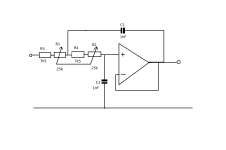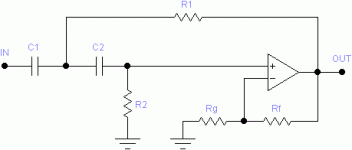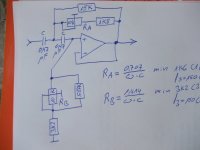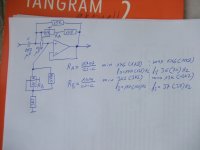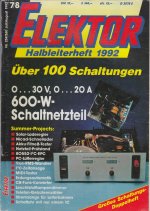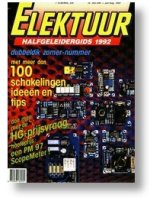Low pass Sallen-Key filter with variable cut-off frequency there are often to find - go to first attachment.
In case of filters with high pass character and variable cut-off frequency in commercial active crossover network devices I find always switches (for variation the values of C1 and C2 in second attachment) but never a stereo potentiometer for R1 and R2.
The reason therefore is the fact, that the character of filter isn't constant over the entire angle of 270° rotation as long as the potentiometer is a linear version.
There was sometimes describe an approach (with schematic) in an Elektor (Elektuur) article (80s or 90s) that solved this problem by adding different resistors to the used stereo- resp. tandem-potentiometer for R1 and R2 (both serial resistors and parallel resistors - but in different kind for R1 and R2). These additional resistors made it possible to use a potentiometer for R1 and R2 in the second attachment without affecting the characteristics of the filter over the intended frequency variation range.
This is from my view much more better and more easy to realize than the variation of C1 and C2 (from second attachment) with stepper character switch.
Who can upload this article from elektor ?
Thank you very much.
P.S.: The attachments are from here:
http://www.stefanv.com/calculators/hp41c_sallen_key.html
In case of filters with high pass character and variable cut-off frequency in commercial active crossover network devices I find always switches (for variation the values of C1 and C2 in second attachment) but never a stereo potentiometer for R1 and R2.
The reason therefore is the fact, that the character of filter isn't constant over the entire angle of 270° rotation as long as the potentiometer is a linear version.
There was sometimes describe an approach (with schematic) in an Elektor (Elektuur) article (80s or 90s) that solved this problem by adding different resistors to the used stereo- resp. tandem-potentiometer for R1 and R2 (both serial resistors and parallel resistors - but in different kind for R1 and R2). These additional resistors made it possible to use a potentiometer for R1 and R2 in the second attachment without affecting the characteristics of the filter over the intended frequency variation range.
This is from my view much more better and more easy to realize than the variation of C1 and C2 (from second attachment) with stepper character switch.
Who can upload this article from elektor ?
Thank you very much.
P.S.: The attachments are from here:
http://www.stefanv.com/calculators/hp41c_sallen_key.html
Attachments
Yes. Equal value R and C gives you a Q of 0.5 and you probably want a Butterworth Q of 0.71, but adding gain to the buffer allows you to adjust the Q independently from the frequency. Years ago, we made subsonic filers with a boosted Q, which we called "bump and roll" to provide a bass boost from the subsonic filter. The gain for a Butterworth filter is exactly 2x, 6dB.
https://en.wikipedia.org/wiki/Sallen–Key_topology
You may also want to consider a state-variable filter, which uses common value R and C components, and also provides both high-pass and low-pass outputs.
https://en.wikipedia.org/wiki/State_variable_filter
But while I have little experience with then, digital methods have no such limitations.
https://www.diyaudio.com/community/...ne-for-crossovers-room-correction-etc.349818/
https://en.wikipedia.org/wiki/Sallen–Key_topology
You may also want to consider a state-variable filter, which uses common value R and C components, and also provides both high-pass and low-pass outputs.
https://en.wikipedia.org/wiki/State_variable_filter
But while I have little experience with then, digital methods have no such limitations.
https://www.diyaudio.com/community/...ne-for-crossovers-room-correction-etc.349818/
Last edited:
Maybe it is very unpolite, but I do have an question about my Kenwood A-1001 which has the same problem as you described in your thread in 2005! I am sorry, but can you (Tiefbassuebertr) help me please? I hope you will.
check out post #3 underMaybe it is very unpolite, but I do have an question about my Kenwood A-1001 which has the same problem as you described in your thread in 2005! I am sorry, but can you (Tiefbassuebertr) help me please? I hope you will.
https://www.diyaudio.com/community/...ds-integrated-amp-a-1001.252315/#post-7465416
Then this way reach the same goal.If you use the Sallen-Key topology with gain like shown on your second drawing you can use a simple dual-gang pot with series resistance (like shown for the lowpass case) because both resistors can be made equal if the gain is chosen accordingly.
Regards
Charles
The schematic of the asked article from elector I have found (go to attachment), but there is realized a buffer (i. e., only unity gain) and obviously the additional resistors only in this case will be necessary (if I remove the additional resistors, the lower and upper end of one potentiometer half gets different fo resp. f-3db - values in brackets of attached schematics are those without the additional resistors).
Attachments
This is the German elektor issue and article:
Durchstimmbarer Hochpass 2. Ordnung (variable 2nd order high pass):
Continuously adjusting the lower corner frequency is not that easy compared to a 2nd order low-pass filter.........)
https://www.elektormagazine.de/magazine/elektor-199207/29973
not to find in the version from United States
https://www.worldradiohistory.com/Archive-Elektor-USA/Elektor-Electronics-USA-1992-07-08.pdf
and also not in the version of Netherlands (elektuur Halfgeleidergids 1992)
https://www.elektormagazine.nl/magazine/elektor-199207
Durchstimmbarer Hochpass 2. Ordnung (variable 2nd order high pass):
Continuously adjusting the lower corner frequency is not that easy compared to a 2nd order low-pass filter.........)
https://www.elektormagazine.de/magazine/elektor-199207/29973
not to find in the version from United States
https://www.worldradiohistory.com/Archive-Elektor-USA/Elektor-Electronics-USA-1992-07-08.pdf
and also not in the version of Netherlands (elektuur Halfgeleidergids 1992)
https://www.elektormagazine.nl/magazine/elektor-199207
Attachments
Last edited:
If you are willing to use a second OP-AMP as buffer then it's a piece of cake to do this with a stereo pot.
Regards
Charles
Regards
Charles
- Home
- Loudspeakers
- Multi-Way
- Subsonic/High Pass Sallen-Key Network with variable Cut-Off Frequency and Potentiometer instead Rotary Switch for Capacity Selecting
